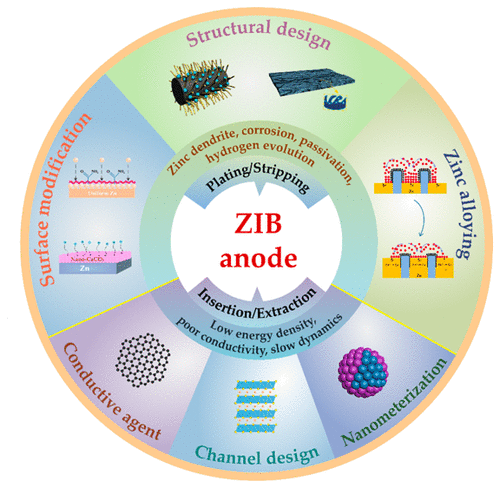Our official English website, www.x-mol.net, welcomes your
feedback! (Note: you will need to create a separate account there.)
Anode Materials for Aqueous Zinc Ion Batteries: Mechanisms, Properties, and Perspectives
ACS Nano ( IF 15.8 ) Pub Date : 2020-12-14 , DOI: 10.1021/acsnano.0c07041
Tingting Wang 1 , Canpeng Li 2 , Xuesong Xie 2 , Bingan Lu 3 , Zhangxing He 1 , Shuquan Liang 2 , Jiang Zhou 2
ACS Nano ( IF 15.8 ) Pub Date : 2020-12-14 , DOI: 10.1021/acsnano.0c07041
Tingting Wang 1 , Canpeng Li 2 , Xuesong Xie 2 , Bingan Lu 3 , Zhangxing He 1 , Shuquan Liang 2 , Jiang Zhou 2
Affiliation

|
Aqueous Zn-ion batteries (ZIBs) are promising safe energy storage systems that have received considerable attention in recent years. Based on the electrochemical behavior of Zn2+ in the charging and discharging process, herein we review the research progress on anode materials for use in aqueous ZIBs based on two aspects: Zn deposition and Zn2+ intercalation. To date, Zn dendrite, corrosion, and passivation issues have restricted the development of aqueous ZIBs. However, many strategies have been developed, including structural design, interface protection of the Zn anode, Zn alloying, and using polymer electrolytes. The main aim is to stabilize the Zn stripping/plating layer and limit side reactions. Zn2+-intercalated anodes, with a high Zn2+ storage capacity to replace the current metal Zn anode, are also a potential option. Finally, some suggestions have been put forward for the subsequent optimization strategy, which are expected to promote further development of aqueous ZIBs.
中文翻译:

水性锌离子电池负极材料:机理,性质和观点
锌离子水电池(ZIBs)是有前途的安全储能系统,近年来受到了广泛的关注。基于Zn 2+在充电和放电过程中的电化学行为,本文基于Zn沉积和Zn 2+嵌入两个方面,综述了用于水性ZIBs的阳极材料的研究进展。迄今为止,锌枝晶,腐蚀和钝化问题限制了水性ZIBs的开发。但是,已经开发了许多策略,包括结构设计,锌阳极的界面保护,锌合金化以及使用聚合物电解质。主要目的是稳定Zn剥离/镀层并限制副反应。Zn 2+嵌入的阳极,具有较高的Zn 2+替代当前的金属Zn阳极的存储容量也是一种潜在的选择。最后,针对后续优化策略提出了一些建议,有望促进水性ZIBs的进一步发展。
更新日期:2020-12-22
中文翻译:

水性锌离子电池负极材料:机理,性质和观点
锌离子水电池(ZIBs)是有前途的安全储能系统,近年来受到了广泛的关注。基于Zn 2+在充电和放电过程中的电化学行为,本文基于Zn沉积和Zn 2+嵌入两个方面,综述了用于水性ZIBs的阳极材料的研究进展。迄今为止,锌枝晶,腐蚀和钝化问题限制了水性ZIBs的开发。但是,已经开发了许多策略,包括结构设计,锌阳极的界面保护,锌合金化以及使用聚合物电解质。主要目的是稳定Zn剥离/镀层并限制副反应。Zn 2+嵌入的阳极,具有较高的Zn 2+替代当前的金属Zn阳极的存储容量也是一种潜在的选择。最后,针对后续优化策略提出了一些建议,有望促进水性ZIBs的进一步发展。































 京公网安备 11010802027423号
京公网安备 11010802027423号